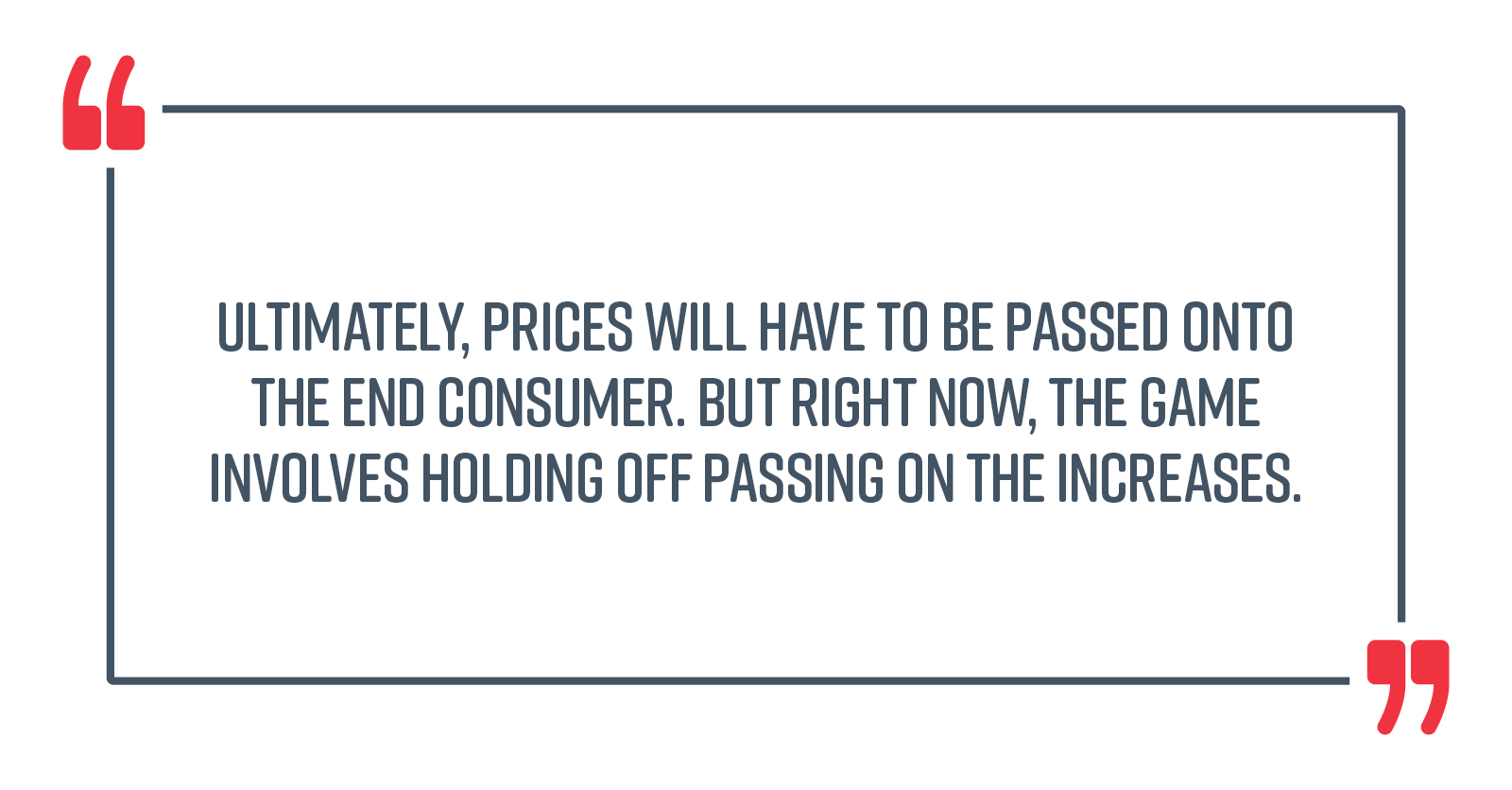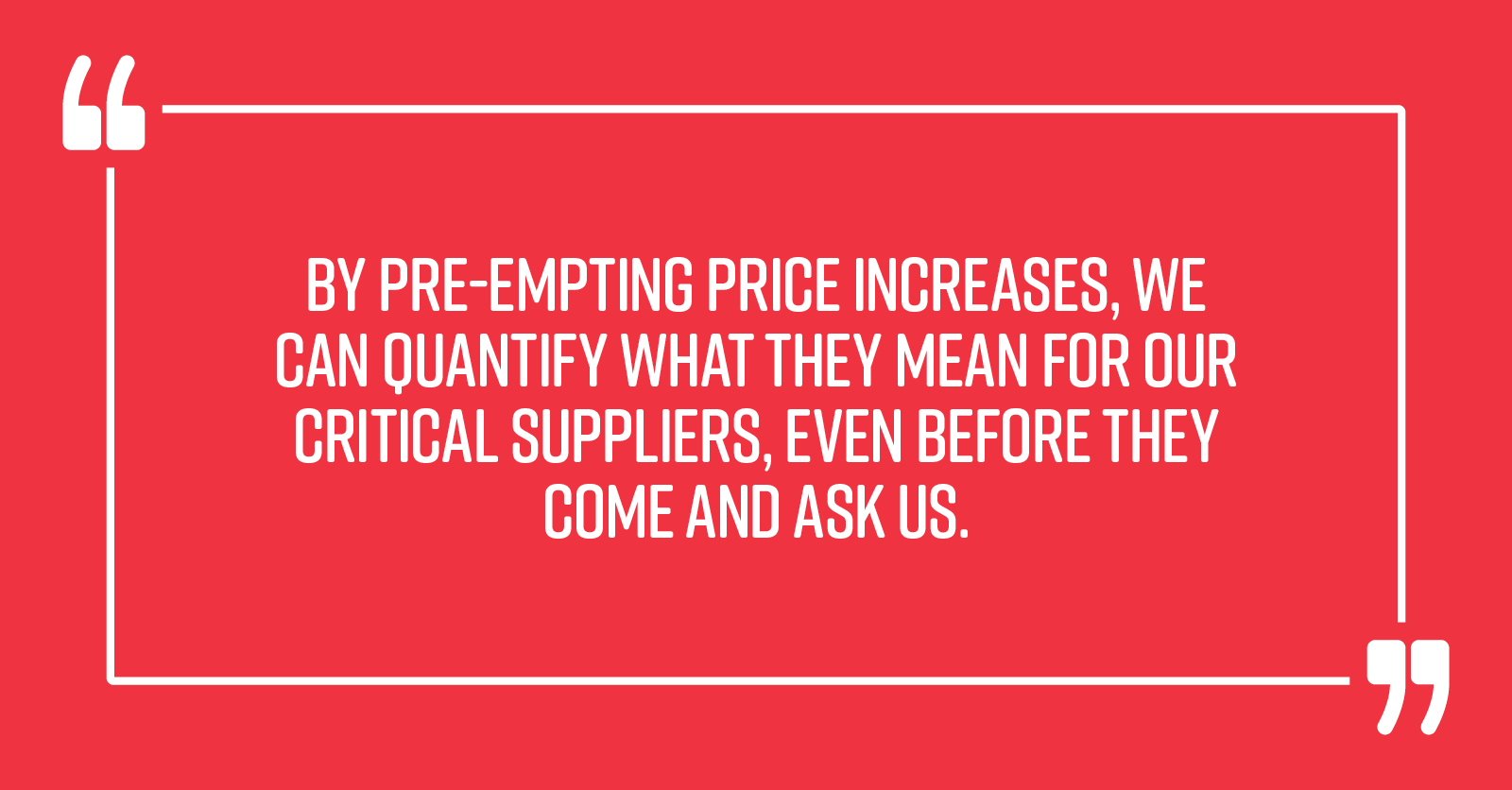Amid today’s unprecedented inflationary environment, Jonathan O’Brien considers a four-step sequence of tactics that procurement professionals can use to handle suppliers’ price increase demands, minimize their impact and stay in control.
Make no mistake, prices are rising, and we won’t see an end to the current inflationary environment for at least a year or two.
First, energy prices are going up around the world and they’re unlikely to come back down any time soon. Next the cost of fossil fuel energy is going up to tackle the emissions crisis. We are also facing post-Covid logistical issues as a result of suppliers that failed or stopped production. These matters have created something of a perfect storm.
As we emerge from the pandemic, inflation will increase more generally as price increases filter through to the consumer.
Consider, for example, an automotive company facing massive supplier price increases. The obvious thing would be to put up the price of its cars to the consumer. The problem is, everybody’s doing that! Do you want to be the one that goes first and erodes your market share? Instead, companies have been withdrawing their dealer margins, those incentives to encourage people to buy. Ultimately, prices will have to be passed onto the end consumer. But right now, the game involves holding off passing on the increases.

Of course, you can’t protect yourself against inflationary increases. It is about the degree to which you can gain an advantage in a marketplace at any one time. If everything’s going up and yours goes up with it, that doesn’t matter, because you are one of many. But you don’t want to be the one that sticks out.
Sometimes, you can claim an advantage if you are able to be the one practising cost leadership when everybody else is putting prices up. Today’s problem is scarcity across many sectors. As a result, it is a sellers’ market and manufacturers are recognizing that scarcity has a value.

1. Say ‘no’
If you are in a procurement role and you’ve got suppliers beating down your door for price increases, what can you do? On the one hand, you must try to fend them off. And, on the other hand, you need to figure out how critical that supplier is.
Ask yourself, ‘Can we switch? Is there somebody we can switch to? What alternatives do we have?’ If, for whatever reason, you need that supplier, then you have to take seriously what they’re saying.
If you have alternatives, your first tactic as a buyer is to say, ‘No. We can’t entertain it, it’s not possible. There’s no budget. We’ve agreed a price mechanism in the contract. We can’t entertain this. Go away and absorb it.’ That’s tactic number one. You must take great care playing that tactic because, if the supplier is important, the approach could be a risky one.
Pushing away does two things: it tests how serious the supplier is, because everybody is saying, ‘I need a price increase’. Is this hurting them to the point where it’s unsustainable and they’re going to stop supply? Or are they just asking for an increase because everybody else is? Saying ‘no’ is not necessarily a bad thing but do it cautiously.
2. ‘Help us out here’
Step two is, ‘Help us out here. We’ve had a working relationship for years. The future is bright. We want you to be part of it.’ Sell the vision. What many procurement functions don’t know for, perhaps, an area of spend that’s been stable for a number of years, is whether a supplier is making a really good margin. If so, should you continue to allow that or is it time to squeeze it? They may recognize that they need to give up margin and share the pain. You should test that by saying, ‘We can’t pass this on easily, we both have to take some pain.’ Their reaction will tell you a lot. They may say, ‘We understand, but not to that extent’ which is negotiation-speak for, ‘Yes, I’ll give you something.’ Or they might say, ‘No, absolutely not. That’s unsustainable for us.’
While we won’t know for certain, this is about testing how serious the supplier is and whether they have any ability to help. We can end up in these situations where we have long-term contracts for areas of supply.
3. Push for a breakdown
If a supplier is asking for a 15 per cent increase, how do we know if this is fair? Perhaps it should be 10 or even 20?
We can ask them for a breakdown that quantifies material, energy costs and labour costs. Raw material prices can be easily quantified as they are published around the world. Labour price increases can be demonstrated by suppliers. Next, it is important to figure out the relative proportions. Let’s say something costs ten euros and the raw materials cost two euros. If the supplier claims the cost of raw materials has gone up by 10%, then, actually, it’s only 2% of the overall figure. We have to ask for the breakdown in order to work out what the proportionate figure is. It’s very hard for a supplier to refuse to provide that. If they’re asking for an increase, it is fair and reasonable for us to ask them to quantify it. There is also an opportunity to gain a territory here, depending on how far we want to push them. Challenging can buy us time but we need to understand the risk as we could be jeopardising supply.
4. Delay
The process in itself buys us time but we should be clear about the level of risk. In this scenario where the supplier is coming to us for a price increase, the power of time is completely in our favour. We can stall as long as we like. The only way the supplier can gain that power back, is to take away the time that’s on our side and threaten to stop supply. The trick here is seeing how serious they are. A supplier might ask for an increase but, if they lack conviction and urgency, you know it’s not hurting him.
We have to test to see how serious they are. We have to push it to see if they are genuine. For most sales account managers, this is unchartered territory. They may be great at negotiating deals previously, but they probably lack training in negotiating price increases with a contract in place. And maintaining a relationship will be their number one objective. If we push back hard, it will test whether they desperately need an increase or just want to get what they can.
Finally, we will figure out when we will agree any price increase. We might put a process in place that says, ‘Look, the contract’s up in a few months, we’ll agree something then.’ Of course, that is another test. If they are desperate for a price increase, they’re not going to agree. Delay is the final way that we can gain an advantage here.
Strategic suppliers
To manage our risk, we should ask ourselves, ‘What does our organization do? And what does the risk expose to us right now?’ Any organization worth its salt has been doing this and translating it into procurement terms. ‘What are the key risk areas that procurement’s facing?’ Of course, price increase is one of them but there are many others. We should consider the marketplaces that would hurt us if we were not able to manage an increase. Then it’s important to stay in touch with what is happening across the cost inputs and drivers, such as energy and labour costs. What are the raw materials or the services that go into what we produce and what’s happening in those marketplaces? That way, we can be proactive by getting a handle on the markets.
By pre-empting price increases, we can quantify what they mean for our critical suppliers, even before they come and ask us. We will want to have that conversation as we want them to survive and thrive. These are the suppliers that really matter to us, where we want a win-win outcome. For the common supplier where there are alternative options and plenty of people queuing up to supply a generic item, we are more likely to play hardball.

Takeaways
- First, understand where your risk is.
- Next, establish which suppliers are important. In other words, which are the ones you need to work with?
- And, finally, manage the process of agreeing price increases. Be clear where you are pushing people away, asking for a contribution, driving that breakdown and delaying where appropriate to keep the power on your side.
As long as we have choice, we should remember the sequence. Say ‘no’, ask them to help us, push for a breakdown and delay. Those are the four-step tactics we can use in our negotiation approach, to try and get what we want. But we should only use them with the suppliers where we have alternatives.